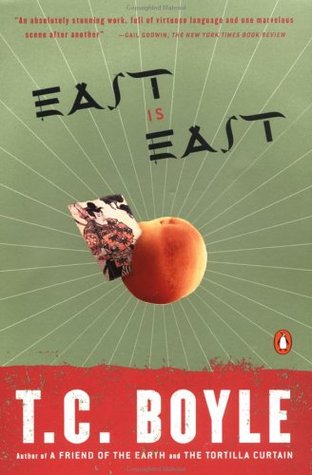One evening, I was listening to a podcast of novelist Margaret Atwood, who observed, “Because what is writing, what is writing in a book, what is a page? A page is essentially a score, like a musical, or it’s a score for voice.” I was struck by it.
Just a few days later I came across a story by T.C. Boyle called the “Relive Box.” I was reading it one morning on my way to work. I usually read during my commutes. I don’t remember anything that morning other than I arrived in time and without mistake. Even though I have to switch trains, I don’t remember doing so. What I do remember is that I was crying when I arrived. It had been a long time since a story had made me feel so vulnerable.
That weekend, I went to one of my favorite bookstores and purchased, blindly, East Is East, without recommendation or forethought because I needed to read more T.C. Boyle, and I figured anything would do. I was right. I was hooked.
East Is East is not one of Boyle’s well-known works. But that didn’t bother me. Boyle is, among other things, very ambitious. In the case of East Is East, he crosses a tricky line. Are men capable of writing persuasively from a woman’s perspective? Can a Black man adequately convince us of a White man’s travails? Certainly the serious writer thinks so. Others aren’t so certain, or find the belief indicative of the larger problem of defining the other without their consent or participation. I recall a good friend’s criticism of Haruki Murakami: “Oh I like his stories just fine, but to me, he fails when he tries to write as a woman. No woman thinks the way he thinks they do.” I don’t think the problem can be resolved so easily. Nor do I think it’s simply a question of artistic ability; that certain writers are more than capable of being anyone, while less talented ones cannot. Boyle, in this case, writes the majority of the novel from the perspective of a young Japanese man who comes to America illegally. He is in pursuit of a romanticized America, the America of his dreams, but once he arrives, this dream turns into a nightmare. And while I’ll allow the reader to determine whether Boyle accomplishes making Hiro Tanaka an authentic character, one thing is for certain: Boyle is no amateur. And the tragedies that befall Hiro are really just the ironies of two cultures unaware of the other’s motives, the classic “lost in translation” moment reproduced at every turn, which throughout the novel collect in a well until they become too burdensome to overcome.
If Atwood considers the page as a score, then Boyle is my current favorite musician. His writing is manic, untamed, and decadent—it beats and slaps and shakes like a jazz saxophonist in the throes of jus grew. And yet it is perfectly disciplined. His writing is frictionless, easily digestible, but always surprising and crisp. In short, T.C. Boyle is not your average novelist. He is ready to push boundaries. And he does so with the skill of an auteur.





